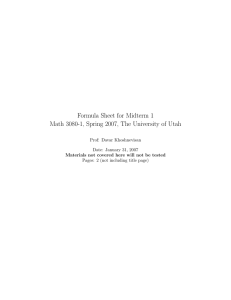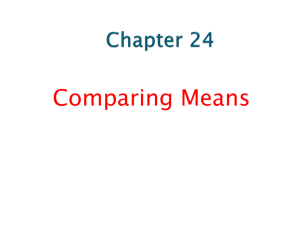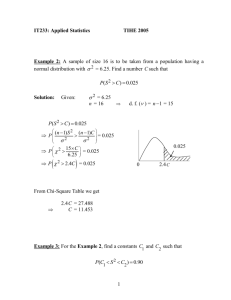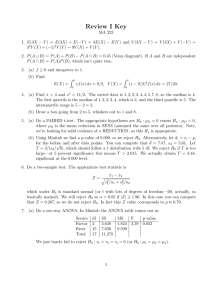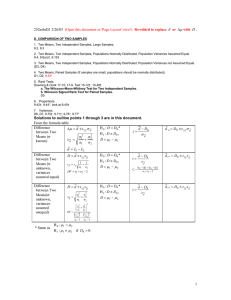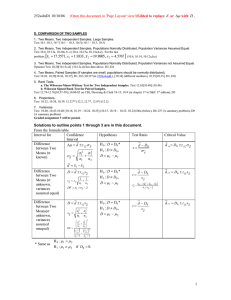Math 5090–001, Fall 2009 Solutions to Assignment 4
advertisement
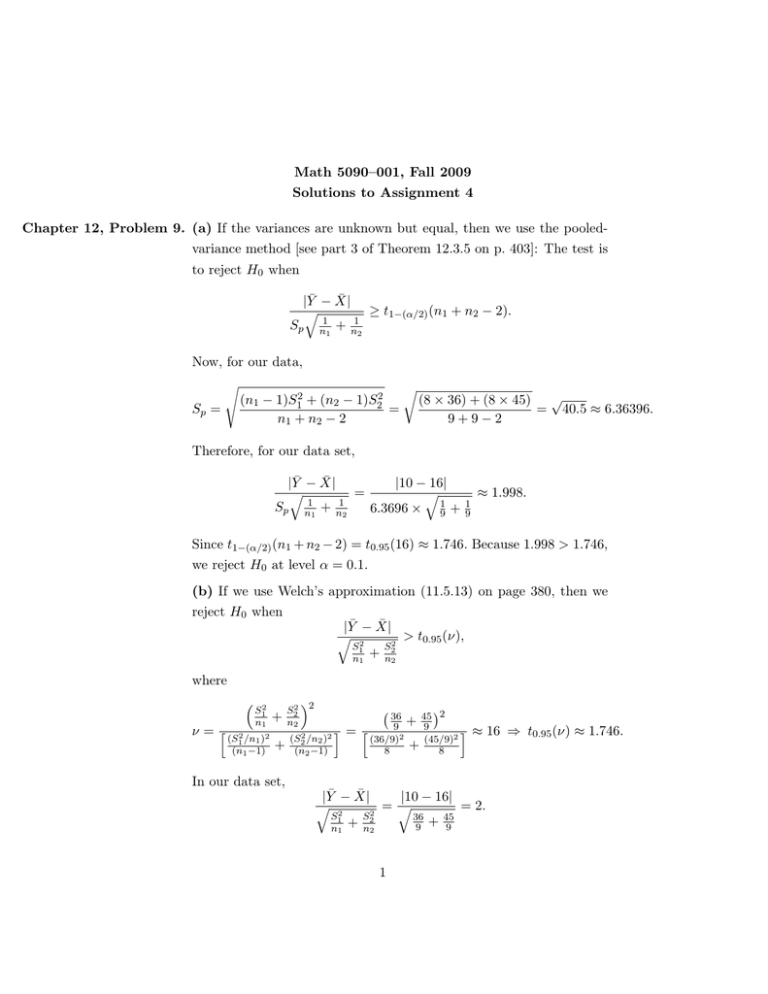
Math 5090–001, Fall 2009
Solutions to Assignment 4
Chapter 12, Problem 9. (a) If the variances are unknown but equal, then we use the pooledvariance method [see part 3 of Theorem 12.3.5 on p. 403]: The test is
to reject H0 when
|Ȳ − X̄|
q
≥ t1−(α/2) (n1 + n2 − 2).
Sp n11 + n12
Now, for our data,
s
Sp =
(n1 − 1)S12 + (n2 − 1)S22
=
n1 + n2 − 2
r
(8 × 36) + (8 × 45) √
= 40.5 ≈ 6.36396.
9+9−2
Therefore, for our data set,
|Ȳ − X̄|
|10 − 16|
q
q
=
1
1
Sp n1 + n2
6.3696 × 19 +
≈ 1.998.
1
9
Since t1−(α/2) (n1 + n2 − 2) = t0.95 (16) ≈ 1.746. Because 1.998 > 1.746,
we reject H0 at level α = 0.1.
(b) If we use Welch’s approximation (11.5.13) on page 380, then we
reject H0 when
|Ȳ − X̄|
q 2
> t0.95 (ν),
S1
S22
n1 + n2
where
S12
n1
ν = h (S 2 /n
2
1)
1
(n1 −1)
2
+
S22
n2
+
(S22 /n2 )2
(n2 −1)
i=
2
36
+ 45
9
9
h
i
(36/9)2
(45/9)2
+
8
8
≈ 16 ⇒ t0.95 (ν) ≈ 1.746.
In our data set,
|Ȳ − X̄|
|10 − 16|
q 2
=q
= 2.
2
S1
S2
36
45
+
+
9
9
n1
n2
1
This is greater than 1.746, so we reject H0 in this way, as well. Note
that in this case, we are not assuming a priori that σ1 = σ2 .
(c) If we know that this is in fact paired data with SD = 9 and
n = n1 = n2 = 9, then we use (11.5.17) from page 381 to find that we
reject H0 when
|Ȳ − X̄|
√ > t0.95 (n − 1) ≈ 1.86.
SD / n
For our data set,
|10 − 16|
|Ȳ − X̄|
√ = √
√ = 2.
SD / n
81/ 9
This is greater than 1.86. So we reject in the paired-sample case.
(d) According to Theorem 12.3.4 of page 402, we reject H0 if
F =
S12
> f1−α (n1 − 1 , n2 − 1) = f0.95 (8 , 8) ≈ 3.44.
S22
But for our data set F = 36/45 = 0.8. Therefore, we do not reject H0 .
(e) We need to compute
(
power at 1.33 = P
)
σ2
S12
1
> 3.44 2 = 1.33 .
σ2
S22
If σ12 /σ22 = 1.33, then
F :=
S12 /σ12
S12
1
,
=
·
2
2
2
S2 /σ2
S2 1.33
and F ∼ F (8 , 8).
Therefore,
)
σ2
3.44
1
power at 1.33 = P F × 1.33 > 3.44 2 = 1.33 = P F (8 , 8) >
.
σ2
1.33
|{z}
(
≈2.59
Therefore, the power is 0.1 against Ha : σ12 /σ22 = 1.33.
2
Chapter 12, Problem 31. First of all, note that this is not a Paréto distribution, but related
closely to one. A second notable remark is that the parameter space
has to be the collection of all θ > 0.
Now, the GLR tells us to reject when λ is large, where
Q
θ0n nj=1 Xjθ0 −1
f (X; θ0 )
λ :=
=
Q
maxθ6=θ0 f (X; θ)
θ̂n nj=1 Xjθ̂−1
n
n
X
θ0
=
exp (θ0 − θ̂)
log Xj
θ̂
j=1
n
X
θ0
,
= exp (θ0 − θ̂)
log Xj + n log
θ̂
j=1
where θ̂ is the MLE for θ [restricted to θ 6= θ0 ].
Next, we find the MLE by maximizing the following likelihood function
over θ 6= θ0 :
L(θ) := θn
n
Y
Xjθ−1
j=1
n
X
= exp n log θ + (θ − 1)
log Xj .
j=1
Equivalently, we maximize log L(θ) = n log θ+(θ−1)
Pn
j=1 log Xj
[this
is the the log-likelihood]. Now,
n
n X
d
log Xj ,
log L(θ) = +
dθ
θ
j=1
d2
n
log L(θ) = − 2 < 0.
2
dθ
θ
Therefore, the MLE is
n
.
j=1 log Xj
θ̂ = − Pn
This is sensible because 0 < Xj < 1, so that log Xj < 0. This is also
the MLE among all θ 6= θ0 , since P{θ̂ = θ0 } = 0 [θ̂ has a pdf]. Plug
3
to find that
λ = exp −n
θ0
− 1 + n log(θ0 /θ̂) .
θ̂
Because θ0 is a fixed positive constant, we reject when
λ1 := −n
θ0
θ̂
− 1 − log(θ0 /θ̂)
is large. I.e., reject when
λ2 :=
θ0
θ̂
− 1 − log(θ0 /θ̂)
is small.
Next we want to do asymptotics [this portion is not graded] for n → ∞.
Since 1/θ̂ is the average of n i.i.d. random variables, it is approximately
normal with mean
1
Z
µ := −E log X1 = −θ
log(x)x
θ−1
Z
∞
dx = θ
0
ye−θy dy
[y := − log x]
0
1
= .
θ
and variance
Z 1
1
1
1
1
1
2
2 θ−1
(log x) x
dx − 2
Var (log X1 ) =
E |log X1 | − 2 =
θ
n
n
θ
n
θ
0
Z ∞
1
1
1
=
θ
y 2 e−θy dy − 2 = 2 .
n
θ
nθ
0
Therefore, under H0 ,
√
n θ0
1
1
−
θ
0
θ̂
≈ N(0 , 1).
And this is another way of saying that
θ0
1
− 1 ≈ √ N(0 , 1).
n
θ̂
4
(1)
Now we return to the test. First, by Taylor–McLaurin expansion,
1
ln υ ≈ (υ − 1) − (υ − 1)2
2
for υ ≈ 1.
Or equivalently,
1
υ − 1 − log υ ≈ (υ − 1)2 .
2
Since θ̂ ≈ θ0 [under H0 ] with high probab., it follows from a 2-term
Taylor expansion of the log that
1
λ2 ≈
2
θ0
θ̂
2
−1
Therefore, (1) implies that
λ2 ≈
1 2
χ (1).
2n
That is, 2nλ2 is approximately a central χ2 (1). So approximately:
Reject H0 when 2nλ2 ≤ χ2α (1).
An Aside on the MLE. Let g(x) := 1/x to find from Taylor expansion that
θ̂ − θ0 = g(1/θ̂) − g(1/θ0 ) ≈
1
1
−
θ̂ θ0
0
g (1/θ0 ) =
−θ02
1
1
−
θ̂ θ0
.
Since the right-most bracketed term is asymptotically normal with
mean zero and variance (nθ02 )−1 , we find that
√ n θ̂ − θ0 ≈ −N(0 , θ02 ) = N(0 , θ02 ).
5

